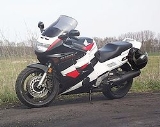
Honda CBR1000F
Encyclopedia
Launched in 1987 the Honda CBR1000F, also known as the Hurricane, is a sport touring motorcycle manufactured by Honda
from 1987 to 1999. It is powered by a liquid-cooled, DOHC, 998 cc, 16-valve four-cylinder, it crossed the 130 bhp barrier and is capable of 260 km/h (161.6 mph).
In 1992, the bike's looks were overhauled with a more streamlined and modern looking bodywork added. The biggest change was the introduction of DCBS, Honda's Dual Combined Brake System. The DCBS system was introduced to assist rider braking where the front brake lever operates the front calipers but also proportionally applies the rear brake, while using the rear brake will engage one front caliper. Since then DCBS has evolved into a very popular addition to many Honda touring motorcycles. No major changes occurred after 1992. A touring model was briefly launched that offered a larger screen and hard panniers.
The seat is 780 mm (30.7 in) high and the wheelbase is 1505 mm (59.3 in).
The engine is housed in a steel box section perimeter frame, air-assisted 41 mm telescopic front forks and an adjustable monoshock at the rear.
The front brakes are twin 296 mm discs using three piston Nissin calipers, the rear is a single 256 mm disc, and DCBS are used on all models after 1992.
It uses the standard Honda inline four-cylinder 998 cc, four-stroke, DOHC, 16-valve, liquid-cooled power plant.
Running 4x 38 mm CV carburetors and a bore and stroke of 77 millimetre.
It produced 130 bhp at 8,600 rpm and 8.36 kg-m of torque at 6,500 rpm.
The fuel tank is 21 litres (44.4 US pt).
From 1994, Honda introduced the Supersport series with the Tadao Baba
developed Fireblade
, which took sales from CBR1000F.
The model was hence discontinued in the USA from 1996 as the CBR1100XX
was released, but continued to sell in Asia and Europe until Honda finally ended its run in late 1999.
Honda
is a Japanese public multinational corporation primarily known as a manufacturer of automobiles and motorcycles.Honda has been the world's largest motorcycle manufacturer since 1959, as well as the world's largest manufacturer of internal combustion engines measured by volume, producing more than...
from 1987 to 1999. It is powered by a liquid-cooled, DOHC, 998 cc, 16-valve four-cylinder, it crossed the 130 bhp barrier and is capable of 260 km/h (161.6 mph).
History
Manufactured from 1987 to late 1999 the Hurricane went through only three major revisions. In 1989, the bike received a cosmetic makeover with a complete redesign of the front fairing, improvements to the bikes front suspension, larger tyres were added to help cope with the bikes heavy weight and to accommodate radial tyres, improvements were also added to the bikes cam chain tensioner in an attempt to remove the annoying cam chain rattle some riders had reported, the 1989 model also had its power slightly increased to around 135 bhp and the model gained weight.In 1992, the bike's looks were overhauled with a more streamlined and modern looking bodywork added. The biggest change was the introduction of DCBS, Honda's Dual Combined Brake System. The DCBS system was introduced to assist rider braking where the front brake lever operates the front calipers but also proportionally applies the rear brake, while using the rear brake will engage one front caliper. Since then DCBS has evolved into a very popular addition to many Honda touring motorcycles. No major changes occurred after 1992. A touring model was briefly launched that offered a larger screen and hard panniers.
Chassis
The CBR weighs 235 kg (518.1 lb) (1992 model and onwards).The seat is 780 mm (30.7 in) high and the wheelbase is 1505 mm (59.3 in).
The engine is housed in a steel box section perimeter frame, air-assisted 41 mm telescopic front forks and an adjustable monoshock at the rear.
The front brakes are twin 296 mm discs using three piston Nissin calipers, the rear is a single 256 mm disc, and DCBS are used on all models after 1992.
Engine
The CBR's engine went largely unchanged throughout its history.It uses the standard Honda inline four-cylinder 998 cc, four-stroke, DOHC, 16-valve, liquid-cooled power plant.
Running 4x 38 mm CV carburetors and a bore and stroke of 77 millimetre.
It produced 130 bhp at 8,600 rpm and 8.36 kg-m of torque at 6,500 rpm.
The fuel tank is 21 litres (44.4 US pt).
Discontinued
The 'Hurricane' name was officially dropped from the line in 1989 however the bike was never given a replacement name so it was often still referred to by its original title.From 1994, Honda introduced the Supersport series with the Tadao Baba
Tadao Baba
Tadao Baba is a retired Japanese motorcycle engineer, the original designer of the Honda Fireblade.-Career:Baba joined Honda Motorcycles from High School in 1962, aged 18 - the company itself was only 14 years old. Working in the machinery section, he made crankcases and cylinder heads for Honda’s...
developed Fireblade
Honda Fireblade
The Honda Fireblade is a family of sport motorcycles manufactured by Honda since 1992. The first model was designed by Tadao Baba.*CBR900RR, 1992–1995*CBR919RR, 1996–1999*CBR929RR, 2000–2001*CBR954RR, 2002–2003...
, which took sales from CBR1000F.
The model was hence discontinued in the USA from 1996 as the CBR1100XX
Honda CBR1100XX
The CBR1100XX Super Blackbird is a Honda motorcycle made from 1996 to 2007. The bike was developed to challenge the Kawasaki Ninja ZX-11 as the world's fastest production motorcycle, and Honda succeeded with a top speed of . Two years later the title passed to the Suzuki Hayabusa, which reached...
was released, but continued to sell in Asia and Europe until Honda finally ended its run in late 1999.

